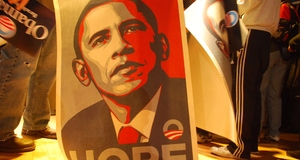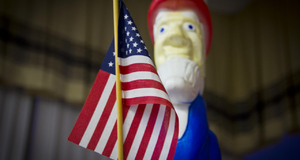Featured Article:Ronald Reagan's Presidential Radio Addresses: Themes of UnityIf Reagan was skilled at creating partisanship, he was equally adept at gaining the favor of groups outside of the Republican sphere. Besides encouraging bi-partisanship to solve problems, bi-partisanship transcended politics into the social realm. That is, no matter what an individual’s political beliefs were, everyone could come together on common ground. The key to doing this, of course, was to find what every American had in common. Considering that America is richly endowed with diversity in every realm, the challenge was tricky. However, as previously seen, one of Reagan’s unmistakable strengths was defining patriotic values and relating them to his audience. Surprisingly, while Reagan could have listed off patriotic values he instead took a broader approach. Listening to his addresses, he consistently implies the one characteristic that every American had in common: they were his constituents who experienced many of the same issues that he was dealing with. In an October 1982 address, he observed: “From the moment we arrived in Washington, we've been working to solve those long-neglected problems that were dragging America down. Like any small businessman, a farmer lives or dies on his ability to sustain an adequate cash flow, and when that cash flow is reduced to a trickle by high inflation and high interest rates, a farmer sometimes has no option but to shut down his operation” (Reagan, 1982). Reagan covered most occupational groups of Americans: merchants, farmers, business owners and so on. In this case, he addressed the plight of the farmer. Even when speaking about the farmer, he broadly integrated this group to cover every American. He used “we” to maintain a sense of inclusiveness. Regardless of the political affiliation of his listeners, by saying, “From the moment we arrived in Washington…,” he said that everyone had a part in his administration, not just Republicans.In a similar manner, Roosevelt’s Fireside Chats focused on a current issue at the time that many Americans were concerned about. Roosevelt would then build momentum by offering his audience a plan of action. In his third chat, Roosevelt announced in July 1933: “After the adjournment of the historical special session of the Congress five weeks ago I wanted the opportunity of a little quiet thought to examine and assimilate in a mental picture the crowding events of the hundred days which had been devoted to the starting of the wheels of the New Deal. Secondly, I wanted a few weeks in which to set up the new administrative organization and to see the first fruits of our careful planning” (Roosevelt, 1933). When examined closely, the attentive observer will notice that Roosevelt uses the plural “our.” Like Reagan’s use of “we,” Roosevelt assured the people that they were facing the difficult situation with the President behind them. The end result was that Roosevelt could strengthen the Democratic Party as well as build a foundation of unity among all Americans. Despite Reagan’s unifying rhetoric, there were always going to be people who disagreed with him. Always keen on his audience, Reagan reached out to traditionally-Democratic groups. These groups included many ethnic, gender, religious and viewpoint-based groups. At the end of the day, he hoped his rhetoric would attract as many of these constituent groups as possible. The most common ethnic group that he addressed was African-Americans. In a June 1985 address focusing on Civil Rights, he reminded Americans: “Discrimination is still not yet a thing of the past, unfortunately; and for the last 4 1/2 years, this administration has acted vigorously to defend and extend every American’s fundamental right to equal treatment. The Justice Department has worked energetically to end discrimination in employment, voting, housing—in all the areas covered by law. Our record on enforcing minority voting rights is at the top of the list. And we've increased to an all-time high the number of criminal civil rights cases filed. We have a proud record on civil rights” (Reagan, 1985). Clearly, this was a “one-size-fits-all” address because it did not mention any particular ethnic group. However, that he was likely alluding to the Civil Rights movement that began three decades prior. To celebrate the positive changes of the Civil Rights movement, he also reminded listeners of his “proud record on civil rights” for the entirety of his Presidency up to that point. Likewise, Reagan spoke politically to Jews in his radio addresses. One method included displaying his knowledge for their unique religious traditions. One Jewish holiday that he felt deserved special recognition was Rosh Hashanah. In September 1982, he made a special address to the nation on prayer. He spoke: “Rosh Hashanah also reminds us of the rich and varied religious heritage we Americans are blessed with. More than any other nation, ours draws inspiration from the creeds of many peoples from many parts of the world. They came to our shores from different ports of origin at different times in our history. But all of them—from the men and women who celebrated the first Thanksgiving more than three and a half centuries ago, to the boat people of Southeast Asia—came here with prayers on their lips and faith in their hearts” (Reagan, 1982). All throughout his life, Reagan followed Christian principles. Many of his addresses subtly incorporated his faith’s inclusiveness into larger patriotic themes. In this case, by using his knowledge of Rosh Hashanah, he could broadly weave Jews into the American patchwork. This patchwork, of course, recognized that many ethno-religious groups were Americans. Not only did they embody American patriotism, but they also brought diversity and precipitated the welcoming attitudes of America towards all walks of life. In addition to reaching out to rhetorically-unifying ethno-religious groups that had an unchanging heritage, he also reached out to people whose beliefs he felt could be changed. In this case, Reagan faced a challenge because, unlike ethno-religious groups, he could not appeal to a viewpoint’s unified heritage. Pro-choice advocates, for example, contained all social groups centering on a specifically-defined viewpoint. In light of this, Reagan spoke earnestly of his beliefs on the issue and supported his points. In an address from January 22, 1983, he said: “I, too, have always believed that God's greatest gift is human life and that we have a duty to protect the life of an unborn child. Until someone can prove the unborn child is not a life, shouldn't we give it the benefit of the doubt and assume it is?” (Reagan, 1982). The timing of the address was effective because, looking closely at the date, it falls on the tenth anniversary of the Roe vs. Wade Supreme Court decision. One of the most notable cases for its division among advocates on either side, the ruling declared that a woman has the right to terminate her pregnancy in most conditions. Reagan paid attention to this timing because the publicity surrounding the event would allow his opinion to reach a much wider audience. Although a President can reveal their moral leanings toward a specific issue, their opinion probably would not be considered as seriously had they argued logically. In this address, Reagan employs arguments based on deism and science. He knew that there would be people in the pro-choice camp that would believe in God, science or both. When using the deistic argument, he argues based on moral grounds. Likewise, when arguing scientifically, he uses logic as the argument’s foundation. Thus, he could “attack” each group within the pro-choice camp, ultimately hoping to create division within it. The broadest group that Reagan reached out to was women because they cover every social group. Reagan strategy here involved appealing to women broadly from all walks of life. He used this strategy during a March 1984 address when he pointed out: “Women in the eighties are a diverse majority with varied interests and futures. Some seek to pursue their own careers; some run for political office; others focus on the home and family. Some seek to do all these things. They are members of a growing group called "working mothers," and sometimes their days resemble a script from "Mission Impossible." Well, no role is superior to another. What's important is that every woman has the right and opportunity to choose the role she wishes—or, perhaps, try to fill them all. And whether the choice be homemaking, career, or both, our administration is trying to help in many different ways. We've increased training opportunities through the Job Training Partnership Act so women can secure permanent, productive employment. For those whose former spouses are delinquent in child-support payments, we've strengthened the Federal child-support enforcement system, and we have additional proposals pending before the Congress. For all women we've provided several forms of tax relief—relief, by the way, which could and should have been passed long ago by those in Washington who had a monopoly on power and who still claim a monopoly on compassion” (Reagan, 1984). Without a doubt, one of the better ways to appeal to a group of people is to commend them on their accomplishments. An aspect that covered the vast majority of women across the nation was their freedom to choose any career they wanted. Reagan built momentum by mentioning one of the most common and noble of jobs: the working mother raising her children. Once he had the attention of women across America, he injected Republican fiscal ideology. In addition to naming legislation used to benefit working mothers, he attacked Democratic law-makers for their “monopoly on compassion.” The end result showed that he honored the efforts of common women everywhere for their compassionate efforts to improve America.Continued on Next Page » Suggested Reading from Inquiries Journal
Inquiries Journal provides undergraduate and graduate students around the world a platform for the wide dissemination of academic work over a range of core disciplines. Representing the work of students from hundreds of institutions around the globe, Inquiries Journal's large database of academic articles is completely free. Learn more | Blog | Submit Latest in Business & Communications |














